Lecture
Structural analysis is a methodological variety of system analysis. It was developed in the 60-70s of the XX century by Douglas T. Ross in the form of the SADT (Structured Analysis and Design Technique) methodology - a technology of structural analysis and design.
The structural analysis is based on revealing the structure as a relatively stable set of relationships, recognition of the methodological primacy of relations over elements in the system, and a partial distraction from the development of objects.
The main concept of structural analysis is a structural element (object) - an element that performs one of the elementary functions associated with the simulated object, process or phenomenon.
Structural analysis involves the study of the system using its graphical model representation, which begins with a general overview and then is detailed, acquiring a hierarchical structure with an increasing number of levels.
This approach is characterized by:
The purpose of structural analysis is to transform general, vague knowledge of the source domain into exact models that describe the various subsystems of the simulated organization.
Decomposition (see the figure) is a conditional technique that allows you to present the system in a form convenient for perception, and evaluate its complexity. As a result of the decomposition of the subsystem, certain structural elements and the relationships between them are distinguished according to certain signs. Decomposition is a means of avoiding difficulties in understanding the system. The depth of decomposition is determined by the complexity and dimension of the system, as well as the objectives of the simulation.
Figure "Decomposition of the organization subsystem into structural elements"
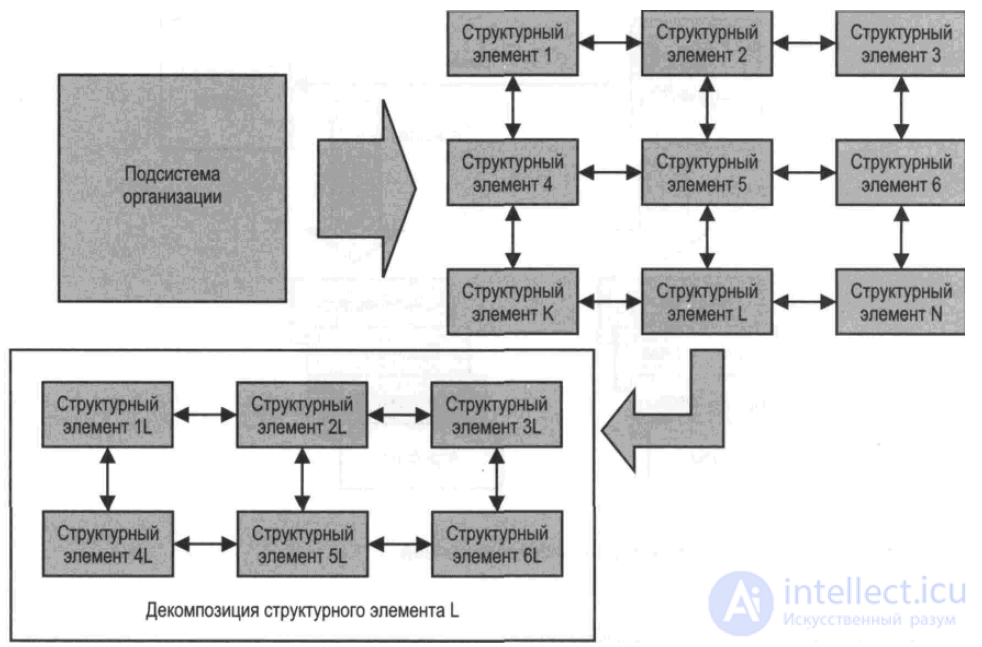
The ARIS methodology also uses decomposition and allows you to refine the subject of modeling using alternative or complementary models.
It should be remembered that not a single subsystem can fully model business processes.
Therefore, to obtain a holistic picture of the organization's activities, it is necessary to take as a basis a description of one of the allocated structures and integrate it with the rest. As practice shows, the basis for such integration is most often a functional or informational subsystem.
Any organization, as a rule, has a large number of subsystems, so the number of structural elements and the relationships between them is very large.
Each structural element (or object) and connection have certain properties that must be described (see. Figure).
One of the varieties of properties are attributes. An attribute is a necessary, essential, inalienable property of an object. Naturally, different structural elements have different attributes.
Each object or relationship also has a set of characteristics (see the figure), with the help of which you can set the quantitative and qualitative characteristics of the modeled elements. In particular, for each function, you can specify its name, unique code in the project, author, time and date of creation, detailed description, implementation example, time and cost of performing this function, etc. All the specified characteristics of objects and relationships are formalized and used in the analysis or report.
Figure “Characteristics of structural elements and relationships”
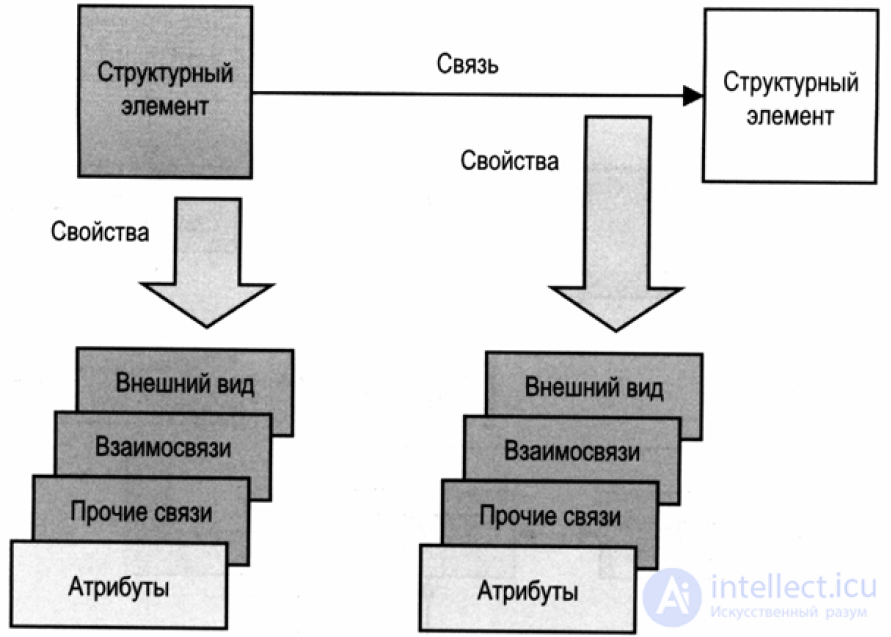
Structural analysis as a set of large dimension due to complex systems modeling techniques tasks should be based on powerful computer support, providing automation systems analysts work. Such tools are CASE-systems (Computer Aided Software Engineering).
The architecture of most CASE-systems is based on the paradigm "methodology - model - notation - means" (see. Figure).
The methodology of structural analysis presents methods and tools for studying the structure and activities of an organization. It defines the basic principles and techniques of using models.
A model is a collection of symbols (mathematical, graphic, etc.) that adequately describes some properties of the modeled object and the relationship between them.
Notation - a system of conventions adopted in a particular model.
Means - hardware and software that implements the selected methodology, including the construction of appropriate models with the notation adopted for them.
When modeling systems in general and, in particular, for the purposes of structural analysis, various models are used that display:
Figure "Architecture of CASE-systems"

Among the variety of tools provided for structural analysis, the most frequently and effectively used are:
IDEF family:
Using these methods, logical models of the initial and reorganized organization management systems can be built.
The created model should answer the following questions:
Recall that the model is a set of objects and the relationships between them, which adequately describes only some of the properties of the simulated system.
The model is just one of many possible interpretations of the system. This interpretation should suit the user in a given situation, at a given point in time.
In the general case, the model is characterized by four properties:
It is also important to emphasize that any model reflects the point of view of a particular group of designers.
Each model has its own goals and objectives, and therefore a business object, which is a complex complex organism, is usually described by a certain set of models that together form the general model of this business system.
The use of many models leads to the need to classify them. A justified classification of objects is their conditional grouping according to specified criteria in accordance with a specific purpose. For different purposes, the same objects can be classified in different ways. Classification is not an end in itself, it is dictated by the needs of theory and practice.
An appropriate classification of models provides convenience when choosing modeling methods and obtaining the desired results.
The most important features by which the classification of models is carried out include:
According to the first sign, the models are divided into logical, material and semantic, or verbal.
Logical models operate according to the laws of logic in a person’s mind or in a computer running a program written by a person. Material models function in accordance with the objective laws of nature.
Semantic, or verbal, models are verbal descriptions of modeling objects. They are applied in a number of cases, in particular, at the initial stages of modeling the organization’s activities, during the survey by staff experts in order to obtain the necessary information.
The main problem that arises when constructing verbal models of an organization’s business processes is the establishment of effective interaction between domain experts (organization employees) and modeling experts.
The figurative, or iconic, models express the properties of the original with the help of visual images having prototypes among the objects of the material world. The ARIS model set includes several models that are essentially figurative or iconic. This, for example, the model "Production Process", "Office Process" and others.
Sign (symbolic) models express the properties of the simulated system using conventional signs or symbols. Figurative and iconic models combine the features of figurative and iconic models. The vast majority of ARIS models are figuratively iconic.
Functional, geometric and functional-geometric models reflect, respectively, only functional, only spatial and at the same time functional and spatial properties of the original. The ARIS methodology does not use these models.
By the second criterion, the models are divided into conditional, similar, and mathematical. Conditional models express the properties and relationships of the original on the basis of an accepted condition or agreement. In such models, similarity with the original may be completely absent. Almost all ARIS models are conditional. It should be noted that figurative and figurative-symbolic models are also conditional.
Similar models have similarities with the original, sufficient to go to the original on the basis of inference by analogy. Such models are also not used in ARIS.
Mathematical models provide the transition to the original, fixation and study of its properties and relationships using mathematical methods. Mathematical models have important advantages - clarity, the possibility of strict deduction, and verifiability. However, in a number of cases, when constructing mathematical models, for example, to describe the process of steel production, practically insurmountable difficulties may arise. Nevertheless, mathematical models are sometimes used in ARIS, in particular, in calculations during the functional-cost analysis. It is possible to qualify models depending on their purpose. From the point of view of taking into account the time factor, static, imitation and dynamic models are distinguished.
Static models describe the content side of the system that does not change over time. They can be functional informational, i.e. describe the structure of information on the basis of which the system functions, and structural, i.e. describe the structure of the system.
When modeling organizations, mainly conditional modeling is carried out, i.e. it is supposed to replace the original with a conditional model, representing it only within the framework of an agreement on the meaning attributed to this model. In this regard, the issue of notations used in symbolic and figurative-symbolic models is of great importance.
The following basic requirements are presented to model notation:
Figure “Designation of objects in the ARIS knowledge structure diagram”
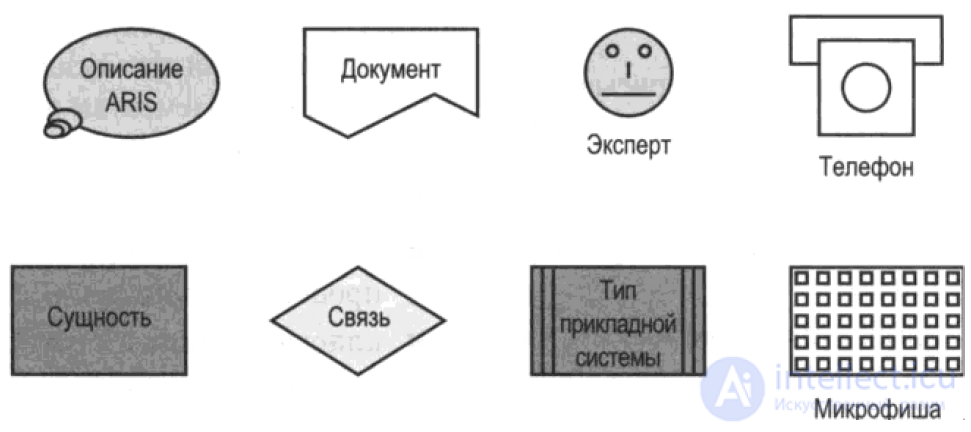
The notation of the graphic model suggests the presence of:
The graphic language provides the structure and exact semantics of the natural language of the model, organizes the natural language in a specific and unambiguous way, which allows us to describe very complex models.
The syntax of a graphic language contains, as a rule, multi-colored geometric figures (rectangles, squares, parallelograms, ellipses, triangles) and conditional images of various kinds.
Built-in objects - objects of other software systems (Word, Excel, mathematical packages) - improve the information richness of the model, make it more complete.
The glossary helps users understand the terminology of the model, thereby facilitating its understanding and use.
Carrying out a structural analysis of an organization involves several stages:
At the first stage, the goals that are planned to be achieved during the structural analysis of the organization’s activities are identified and described. There are usually several of them. In this regard, the goals must be ranked, to build their hierarchy.
When the goals of the reorganization of activities are known, it becomes possible to choose methods for conducting structural analysis. Rigid selection algorithms do not exist. The structural analysis methodology involves the use of one or more models.
Having determined the objectives of the analysis and choosing the tools for its implementation, it is necessary to study in detail how the organization functions. The purpose of the study is to collect data for building models that reflect the activities of the organization.
The main principles of conducting a study of the organization are:
The same principles should be implemented in a methodology that includes descriptions of the program of actions, the objects being studied, the degree of detail of the study, methods for collecting data and the rules for processing them. This technique provides a standardization of the study of the subject area and a formalized presentation of the data.
Information is collected within all the basic structures of the organization.
Most of the information collected is not obvious, formulated and unambiguous. In this regard, before starting the simulation, it is necessary to identify the main structure-forming elements of the control system of the analyzed organization and fix them. These items include:
Organizational structure is the most obvious component of any company. However, there may be problems. So, the problem arises when there is a direct (disciplinary) subordination of one organizational element to another and at the same time an additional (functional) subordination. The most striking example is the bookkeeping of a large company with several lines of business. Accountants serving a certain area of activity of such a company are part of a single accounting department and are subordinate (disciplined) to the chief accountant (sometimes to the financial director). However, functional subordination (within the basic functional responsibilities of accountants serving the direction) implies their subordination to the head of the functional unit (direction).
A characteristic problem is the existence of an informal subordination relationship.
Formally fixed subordination of some employees to others is often absent in practice. As a result, a new organizational structure appears, generally corresponding to the formal, but in certain parts different from it.
The third serious problem is the separation of the legal structure from the managerial one. This feature is typical primarily for holding companies that include several legal entities. The managerial structure (the subordination structure from the point of view of operational management) almost always differs significantly from the legal one. This is because there are different principles and criteria for the formation of managerial and legal structures.
The legal structure is formed from the point of view of the interests of strategic management, as well as from the point of view of the requirements of the business in which the organization is engaged.
The managerial structure is built and optimized in terms of more efficient operational management. As a result, specialists working on the basis of several legal entities can work in one unit (within the management structure).
The structure of the territory may turn out to be important for distributed organizations, where the territorial location of individual divisions (branches) significantly affects the features of the structure of the management system, in particular, business processes.
Despite the fact that in many organizations there are no clearly formulated regulatory documents that describe the rules for doing business and performing related procedures, the structure of the main and auxiliary processes of the top level can be determined, and this should be done at the very beginning of modeling work. This structure is to one degree or another identical for all companies engaged in similar activities. In this regard, it is possible to use existing generalized (reference) models of processes created for various industry areas.
The allocation of process structures will provide further more effective planning and management during the simulation, as well as facilitate the obtaining of structured information about the activities of the simulated organization.
One of the important tasks of increasing the effectiveness of the organization is to optimize document management and create a management accounting system. To solve this problem, it is necessary to have a structured classification system for the entire information space of the organization, including both documents and individual economic, financial, production and other indicators.
Formation of this structure - one of the highest priorities of modeling stages.
Tasks associated with the creation and implementation of information technology require a detailed analysis of existing information systems - their structure and participation in the organization's business processes. In this regard, it is necessary in advance, before detailed modeling of processes, to form a structured list of all information systems of interest, and also to evaluate their internal structure (first of all, a set of basic modules and screen forms).
Thus, in order to build an adequate and popular model of organization, it is necessary, at the initial stages of modeling, to think about isolating and fixing all the fundamental structures. Their competent formation provides a quality "reserve" for the future. This will allow thoughtfully and predictably to develop all new detailed models that have a certain place in the general model of the structure of the organization and correspond to the objectives of the analysis of individual elements and the organization as a whole.
The quality and quantity of information obtained during the study of the organization depends on how adequate the constructed model will be.
The development of models of the organization includes several stages:
The constructed model should be optimized according to criteria of interest to the user. After that, an analysis of the models is carried out, the results of which are used to reorganize the activities.
The structural parameter reflecting the excess of the total number of bonds over the minimum necessary will be called structural redundancy R. It is defined as follows:
 (2)
(2)
This characteristic is used to indirectly assess the economy and reliability of the aircraft under study. For systems with maximum redundancy, having a full graph structure  ; for systems with minimal redundancy R = 0; for disconnected systems
; for systems with minimal redundancy R = 0; for disconnected systems  . Thus, a system with a large R is potentially more reliable. It is advisable to supplement it with another parameter that takes into account the unevenness of ties.
. Thus, a system with a large R is potentially more reliable. It is advisable to supplement it with another parameter that takes into account the unevenness of ties.  .
.
The uniform distribution of links in the structure of an undirected graph with m edges and n vertices is characterized by an average degree of vertex  . Then, introducing the concept of deviation
. Then, introducing the concept of deviation  Where
Where  - the real degree of the i-th vertex of a given graph, it is possible to determine the quadratic deviation of a given distribution of the degrees of the vertex from the uniform one:
- the real degree of the i-th vertex of a given graph, it is possible to determine the quadratic deviation of a given distribution of the degrees of the vertex from the uniform one:
 (3)
(3)
Indicator  characterizes the underutilized capabilities of a given structure with m edges and n vertices in achieving maximum connectivity.
characterizes the underutilized capabilities of a given structure with m edges and n vertices in achieving maximum connectivity.
The law of redundancy of parts of the system
The law of redundancy of parts of the system provides that approximately 20% of the functions, elements and connections of the system perform about 80% of the work. When creating a workable system, it is necessary to take into account that in order to perform any work, besides the basic elements and connections (performing the main function), approximately 80% of auxiliary is needed, and they, as a rule, perform only 20% of the main work. Taking this into account, it is necessary to envisage an “extra” consumption of substance, energy and information (approximately 20% for the provision of the main function and 80% of the main and auxiliary ones).
Excessiveness may be functional and structural .
Functional redundancy is determined by the fact that in order to ensure the health of the system, in addition to the main function, it is necessary to perform more basic and auxiliary functions .
Structural redundancy is determined by the need to introduce additional elements and connections , except for the working body . To ensure the performance of the system; additional equipment is needed: transmission, power source and energy converter (engine), control system and housing .
Structural - topological characteristics of systems.
When analyzing a system, it is advisable to quantify the quality of the structure of the system and its elements from the standpoint of a system-wide approach.
AT 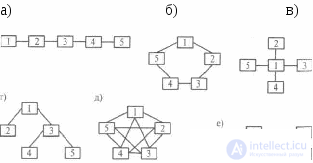 ides of topological structures. Types of topological structures consider the example of five elements.
ides of topological structures. Types of topological structures consider the example of five elements.
. Types of topological structures: a) consistent structure; b) ring structure; c) radial structure; d) tree structure; e) a full graph type structure; e) incoherent structure
Connectedness structure This characteristic makes it possible to single out the presence of breaks, hanging vertices, etc. For undirected graphs, the connectivity of all elements in the structure corresponds to the condition:

In the ratio (4.6) 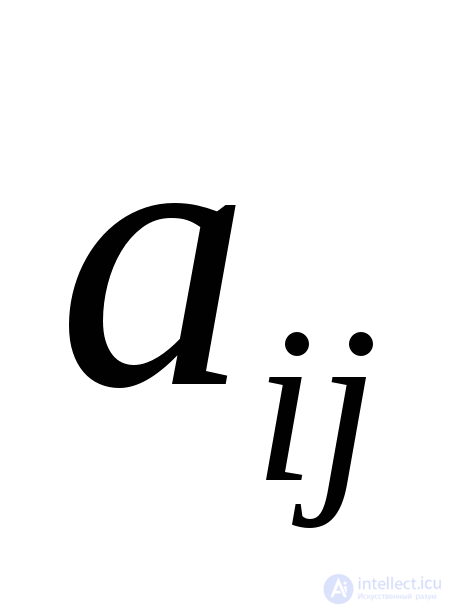 - an element of the adjacency matrix. The right-hand side of (4.6) determines the required minimum number of links in the structure of an undirected graph containing n vertices. The coefficient 0.5 is taken due to the fact that the same relationship d. And a is taken into account twice.
- an element of the adjacency matrix. The right-hand side of (4.6) determines the required minimum number of links in the structure of an undirected graph containing n vertices. The coefficient 0.5 is taken due to the fact that the same relationship d. And a is taken into account twice.
Relation (4.6) can be rewritten as

those. this is nothing but the number of edges in an undirected graph. We define m as a function of n for the main types of structures in general form.
Consistent structure Obviously 
Ring structure. Obviously 
Radial structure. Obviously 
Tree structure. It is difficult to say in general terms, since the parameter is determined by the type of tree.
The structure is a complete graph. For the first element, the number of connections is n-1, since it is associated with all elements except itself. The second element is n-2 connections, because no connection with himself,
and the connection with the first we have already taken into account. Similarly, the third - n-3 IT. d. The latter has 0. because all the connections are taken into account. So, we have

For a disconnected structure, this characteristic does not make sense.
Structural redundancy. This is a structural parameter reflecting the excess of the total number of bonds over the required minimum number of bonds. In relation (4.6), we divide all terms by n-1 and denote the difference by R. Then we will have

Where R is structural redundancy.
Let us find the structural redundancy for the considered type structures in a general form, taking into account the previously found dependence m = m ( n ).

This structural characteristic is used to indirectly assess the efficiency and reliability of the system under study. For systems with redundancy - R > O, for systems with minimal redundancy - R = O, for disconnected systems - R <0.
Structural compactness.
For its evaluation, a parameter is introduced that reflects the proximity of the elements to each other. The proximity of 2 elements i u j determined by the minimum path length for a directed graph (chain - for undirected) - 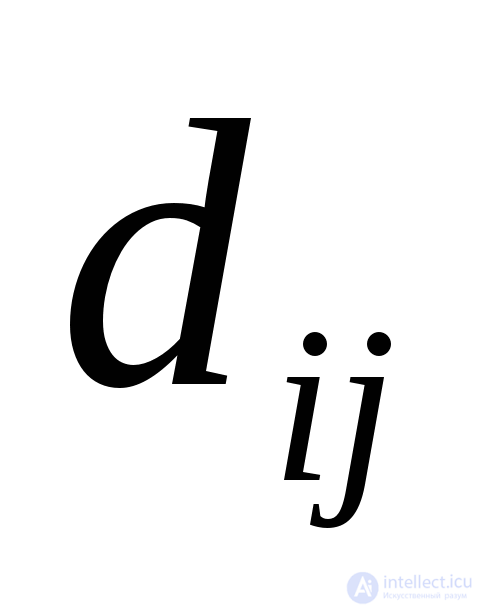 . Then the sum of all minimal paths (chains) between all the elements reflects the habitable structural proximity of the elements in the analyzed structure. Denote this value by Q and, in accordance with the definition, we will have:
. Then the sum of all minimal paths (chains) between all the elements reflects the habitable structural proximity of the elements in the analyzed structure. Denote this value by Q and, in accordance with the definition, we will have:

The degree of centralization of the structure.
1. The least “centralized” and the most “eroded” from these positions are the ring and full graph structures in which the elements are loaded in exactly the same way. For these two structures, structural compactness

Where  - the sum of the distances from the jth element to all others.
- the sum of the distances from the jth element to all others.
2. But, on the other hand, the more compact the structure, the easier it is for the center to manage it. Therefore, we introduce a new parameter (Y, expressed in 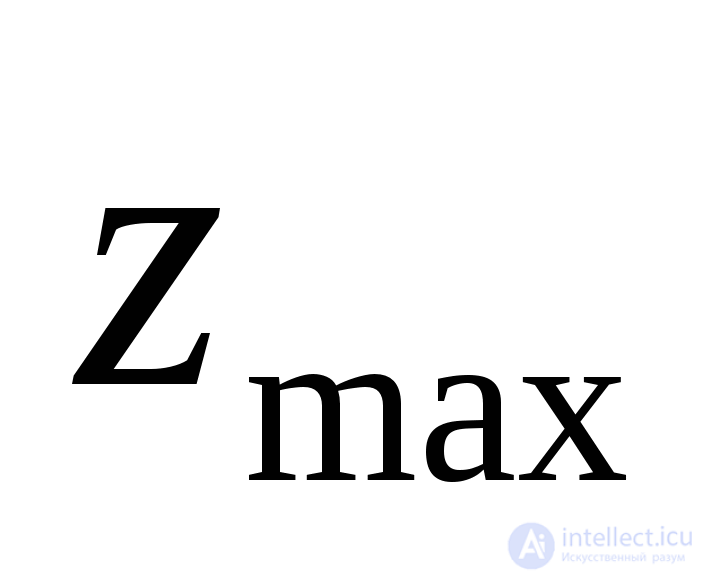 and increasing with increasing compactness.
and increasing with increasing compactness.
We introduce the concept of centrality index, defining it as

For structures with a maximum degree of centralization (radial) 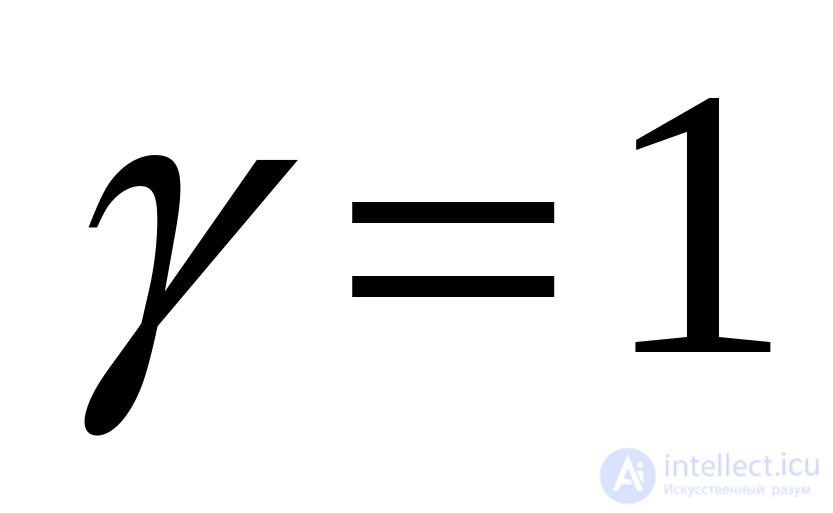 , for structures with uniform distribution of connections (ring and full graph)
, for structures with uniform distribution of connections (ring and full graph) 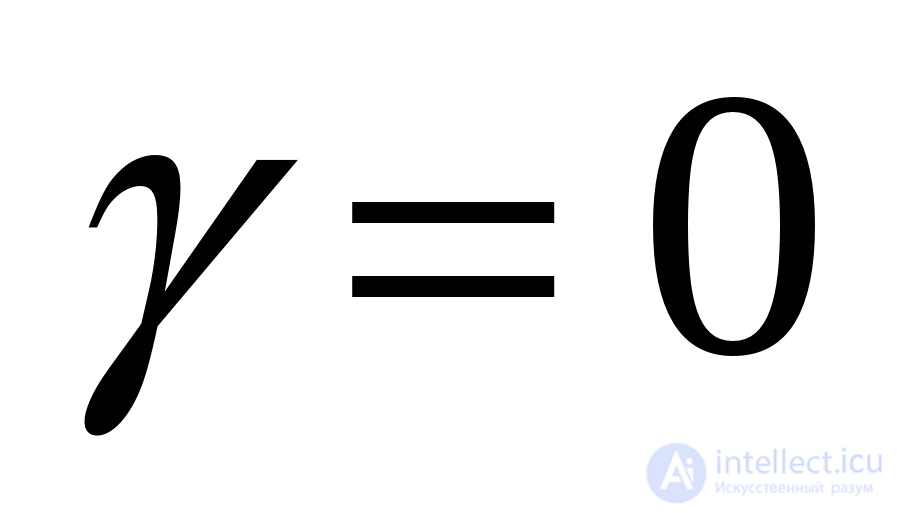 .
.
Comparative analysis of topological structures. The results of the calculation of topological characteristics for typical structures (for the case of 5 elements) are summarized in Table 4.16. For the tree structure, calculations will be made directly based on the definitions of the parameters.
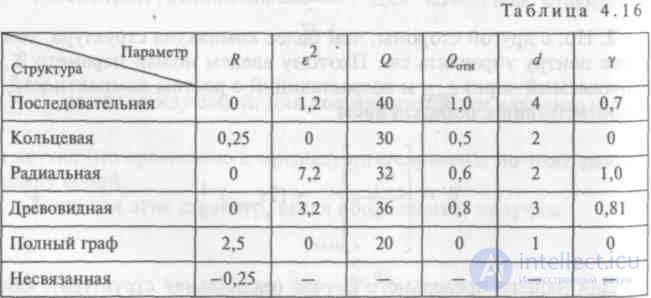
Analysis table. 4.16 shows the following.
For disconnected structures, structural redundancy R <0, for structures without redundancy (sequential, radial, tree) R = 0; for structures with redundancy by connections (ring, full graph) R> 0
 , the radial structure is the most uneven.
, the radial structure is the most uneven.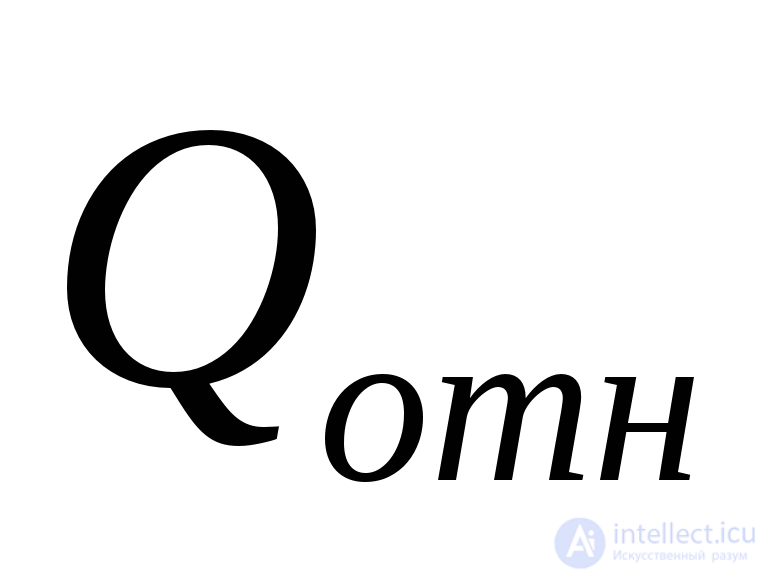 ) has a structure like a full graph, the smallest - consistent.
) has a structure like a full graph, the smallest - consistent.
4. Radial and tree structures having the same or similar values. 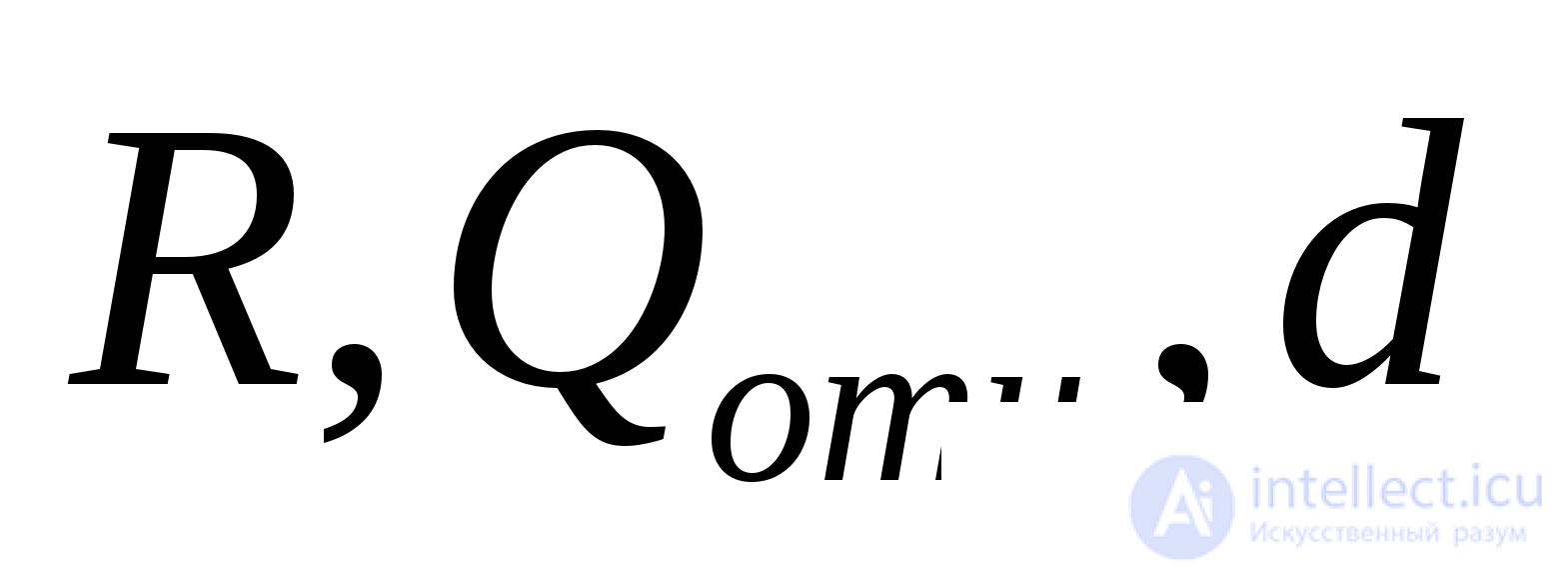 significantly differ in performance
significantly differ in performance 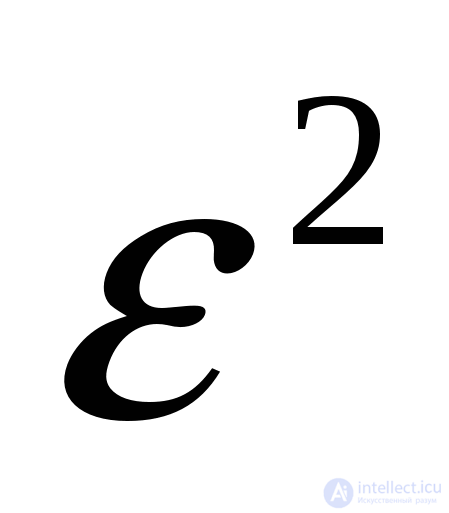 and
and  that corresponds to the physical
that corresponds to the physical
meaning, because a departure from full centralization in the structure leads to a more even distribution of connections among the elements.
The above structural characteristics were obtained only on the basis of information on the composition of the elements and their connections. Further development of the methodology of structural parameters for solving problems of structural analysis can be based on accounting for non-structural information by introducing numerical functions on the graphs. This allows, along with the composition of the elements and the direction of their interaction, to take into account when solving problems other aspects of their functioning (temporary, reliability, cost, etc.)
Let us further consider the third level of formalization of structural analysis tasks, when the composition of the signals of the interrelation of elements and their appearance is taken into account. Recall that at the first level only the presence of a connection between the elements was taken into account, at the second - the presence and direction of this connection.
продолжение следует...
Часть 1 Structural - topological characteristics of systems. Structural redundancy
Comments
To leave a comment
System analysis (systems philosophy, systems theory)
Terms: System analysis (systems philosophy, systems theory)